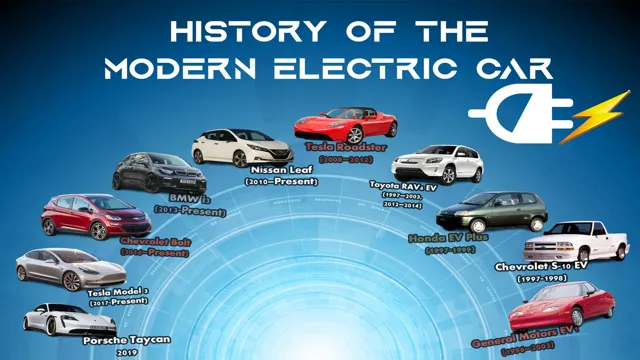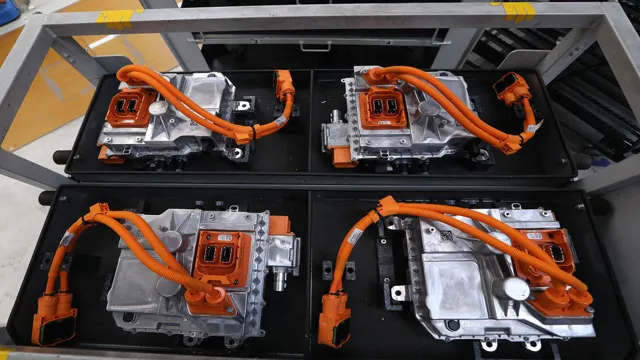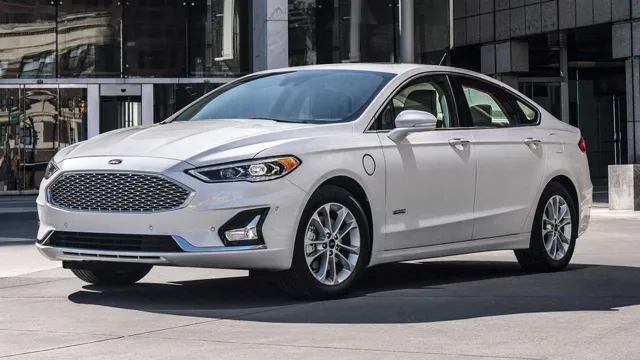The Shocking History of Electric Car Tax Credits: From Inception to Impact
Electric car tax credits have become a popular topic of discussion in recent years, especially among those who are interested in sustainable living and reducing their carbon footprint. In simple terms, a tax credit is an incentive offered by the government to encourage certain behaviors, in this case, the purchase of electric cars. But where did this idea come from and how has it evolved over time? In this blog post, we’ll explore the history of electric car tax credits, from their inception to their current state, and what they mean for the future of clean transportation.
So buckle up, put on your reading glasses, and join us on this electric journey!
Overview
The electric-car tax credit history in the United States dates back to 2008 when the Energy Improvement and Extension Act was signed into law. The act offered a tax credit of up to $7,500 for those who purchase an electric vehicle. Since then, the tax credit has gone through some changes.
For instance, in 2010, President Obama’s administration expanded the credit to include more electric vehicles. However, the credit had some adjustments for phase-out after a carmaker would sell over 200,000 qualified EVs. Tesla, for example, phased out the credit in 2020, while General Motors was already phasing it out by then.
Congress has also made moves to bring back the credit for popular EV brands, such as Tesla and GM. Today, the tax credit still contributes to the growth of the electric car industry by making the cars more affordable to consumers.
The Beginning of the Tax Credit
The tax credit has become a common term in modern times, but it had a humble beginning. The concept of incentivizing taxpayers by offering tax deductions, exemptions, or credits is not new, but the tax credit, as we know it today, came into being in 1916 when the government imposed an income tax on all taxpayers. The purpose was to incentivize taxpayers to contribute towards societal causes, such as charities and non-profit organizations.
Taxpayers who donated to such causes received tax credits, which could be deducted from their tax liability. Although the tax credit system faced some turbulence in its initial years, it gradually evolved into what it is today. The tax credit system has become an integral part of modern tax laws, offering a plethora of opportunities to taxpayers to save money, invest in their future, and contribute towards social causes.

Changes to the Tax Credit over Time
The tax credit is a government incentive that reduces taxpayers’ liability by reducing the amount of tax owed. Over time, the tax credit has undergone numerous changes to adapt to the evolving economic and social landscape. The tax credit was initially introduced in the 1930s to stimulate economic growth and reduce the burden of taxes on low-income earners.
Since then, the tax credit has been revised several times, with each revision aimed at improving its effectiveness and reach. Today, the tax credit is a critical component of the tax code that benefits millions of Americans every year. The changes made to the tax credit over time have made it more accessible and efficient to claim, allowing more people to benefit from this valuable government incentive.
Current Status
Electric-car tax credit history has been somewhat of a rollercoaster ride. The initial tax credit was introduced by the Energy Policy Act of 2005, which allowed for a credit of $2,500 to $7,500 for electric vehicles. However, the credit was set to expire once a manufacturer sold 200,000 eligible vehicles.
This led to a rush for consumers to buy their electric vehicles before the credit was phased out. In 2019, Tesla and GM were the first two manufacturers to reach the 200,000-vehicle limit, which made them ineligible for the tax credit. This caused a decrease in sales for both companies, and it was evident that there was a need to revise the tax credit program.
Currently, the federal government offers a tax credit of up to $7,500 for electric vehicles, depending on the battery size. However, this tax credit is only available until the manufacturer has sold 200,000 electric vehicles. Therefore, it is essential to keep an eye on any changes to this program to ensure that you take full advantage of the tax credit if you are considering purchasing an electric vehicle.
Current Eligibility Requirements
As of now, the current eligibility requirements for various programs and services have undergone several changes. These alterations were made to cater to the evolving needs of individuals and communities. In this fast-paced world, keeping up with these requirements is vital to avoid any disqualifications or delays in receiving benefits.
For instance, eligibility requirements for healthcare programs have been updated to include telemedicine consultations, in light of the global pandemic. Other programs, such as housing assistance, have also seen changes in their requirements to provide relief during these trying times. It’s essential to stay informed about these updates to ensure that you don’t miss any opportunities that you might be eligible for.
Always check with the relevant authorities to get the most current and accurate information in case of any doubts.
Rebate Amounts for Popular Electric Cars
Electric cars have become increasingly popular in recent years due to their eco-friendly nature and low running costs. This has resulted in many governments offering rebates to drivers, incentivizing them to make the switch to electric. The amount of the rebate varies depending on the country and the specific model of electric car.
For example, in the US, the federal tax credit for electric cars ranges from $2,500 to $7,500. However, it is important to note that these rebates are not available indefinitely, and each country has a different set of criteria to be eligible for the program. Overall, rebates make electric cars a more affordable option for many people, and it is worth exploring what incentives are available when considering purchasing an electric vehicle.
Expanding the Tax Credit
The tax credit is a well-known incentive program that encourages taxpayers to invest in specific areas of the economy. As of now, the tax credit is limited to certain industries such as renewable energy and research and development. However, there has been an ongoing discussion about expanding the tax credit to include other sectors such as health care, education, and infrastructure.
The main argument for the expansion is to stimulate economic growth in those areas and to incentivize private investment. As the government considers expanding the tax credit, it is essential to strike a balance between expanding the program while ensuring that it does not unfairly favor certain industries. Overall, the expansion of the tax credit could potentially benefit many sectors of the economy, but it must be approached with caution to avoid unintended consequences.
Future Tax Credit Predictions
The electric-car tax credit history has been a hot topic for quite some time now. In the past, buyers of electric vehicles were able to enjoy a federal tax credit of up to $7,500. However, as the popularity of electric cars has increased, this credit is expected to diminish over time.
While there are currently talks of potential incentives and tax credits for those who purchase electric cars, it is uncertain what the future of these incentives will look like. Some suggest that the tax credit may decrease gradually and eventually be phased out altogether, while others argue that these incentives may be extended or even expanded to reflect the growing emphasis on sustainable transportation. Regardless of the outcome, it’s clear that the future of electric-car tax credits will play a significant role in the adoption and expansion of electric vehicles in the U.
S.
Political Factors and Electric Vehicles
Political factors can have a significant impact on the electric vehicle market, especially when it comes to tax credits. One of the most significant factors to consider is the shift toward renewable energy and a reduced carbon footprint. Governments around the world are encouraging their citizens to embrace green living and transition away from fossil fuels, and tax credits have become one of their primary tools to achieve these goals.
However, predicting the future of these tax credits can be challenging, as political winds are often unpredictable. Many experts predict that the tax credits for electric vehicles will continue at least in the short term, but it remains to be seen how things will develop over time. Whatever the future holds, tax credits will likely play an important role in the transition to renewable energy and the widespread adoption of electric vehicles.
As individuals, we can play our part by researching the current and future tax credits available and taking advantage of them where possible.
The Importance of the EV Tax Credit
The EV tax credit has played a significant role in encouraging consumers to switch to electric vehicles. It has not only made environmentally friendly cars more affordable for the general public but has also helped in reducing the overall carbon footprint of the transportation sector. As the government continues to promote the use of clean energy, the EV tax credit is likely to be extended in the future.
Experts predict that the credit could be expanded to cover the purchase of used EVs, making them more accessible to low and middle-income families. The tax credit may also be made more generous, possibly increasing the amount offered to consumers who purchase EVs. These predictions are not only good news for buyers but for the environment too, as the use of electric vehicles is likely to become even more widespread, leading to a significant reduction in greenhouse gas emissions.
Conclusion
In conclusion, the electric car tax credit has a rich history dating back over a decade, providing incentives for drivers to opt for electric vehicles and reduce their carbon footprint. Despite some bumps in the road, such as expiration and extension deadlines, the tax credit remains a key factor in the growth and adoption of electric vehicles. It’s no shock that as technology continues to advance and environmental concerns become more prevalent, the electric car tax credit will continue to be a driving force in the future of transportation.
“
FAQs
What is the history of the electric-car tax credit?
The electric-car tax credit was first implemented by the Energy Policy Act of 2005 and has been extended multiple times since then.
How much is the electric-car tax credit worth?
The amount of the electric-car tax credit varies depending on the battery capacity of the vehicle, with a maximum credit of $7,500.
Are all electric cars eligible for the tax credit?
No, only eligible vehicles which meet certain criteria such as battery capacity, must be purchased new, and used primarily for personal use.
How long will the electric-car tax credit be available?
The electric-car tax credit is scheduled to phase out once a certain number of vehicles are sold by each manufacturer and is expected to expire for some automakers by the end of 2021.







